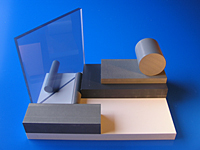
1029 Pulinski Rd Ivyland,
PA 18974
Tel:215-672-5225
Fax:215-672-5582
Email: sales@tridentplastics.com
Website: www.tridentplastics.com
PA 18974
Tel:215-672-5225
Fax:215-672-5582
Email: sales@tridentplastics.com
Website: www.tridentplastics.com


| Items |
 2193-0300 CPVC - "High Temperature" Rod |
 2193-0500 CPVC - "High Temperature" Rod |
 2193-0700 CPVC - "High Temperature" Rod |
 2193-0900 CPVC - "High Temperature" Rod |
 2193-1000 CPVC - "High Temperature" Rod |
|||||
| Tolerance | N/A + 0.002 in- 0.00 in | |||||||||
| Weight | N/A 0.029 lb/ft | N/A 0.066 lb/ft | N/A 0.117 lb/ft | N/A 0.183 lb/ft | N/A 0.265 lb/ft | |||||
| Specific Gravity (ASTM D792) | N/A 1.55 gm/cc | |||||||||
| Hardness - Rockwell (ASTM D785) | N/A R119 | |||||||||
| Water Absorption - 24 hrs, 73°F (ASTM D570) | N/A 0.03 % | |||||||||
| Tensile Strength (ASTM D638) | N/A 8000 psi | |||||||||
| Flexural Strength | N/A 15100 psi | |||||||||
| Flexural Modulus | N/A 415000 psi | |||||||||
| Izod Impact Strength (ASTM D256) | N/A 1.5 ft·lb/in | |||||||||
| Heat Deflection Temperature at 264 psi | N/A 217 ºF | |||||||||
| Flammability Rating (UL 94) | N/A V0 | |||||||||
| Flame Spread (E84) | N/A 15 | |||||||||
| Limiting Oxygen Index (ASTM D2863) | N/A 60 % | |||||||||
| Dielectric Strength (ASTM D149) | N/A 1250 V/mil | |||||||||
| Standard Length | N/A 10 ft4 ft8 ft | |||||||||
|
|
||||||||||